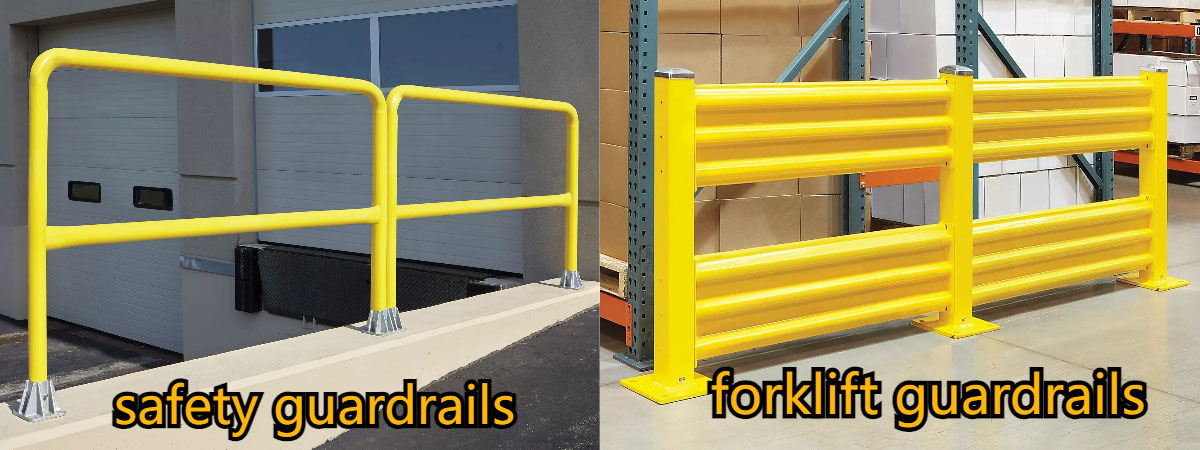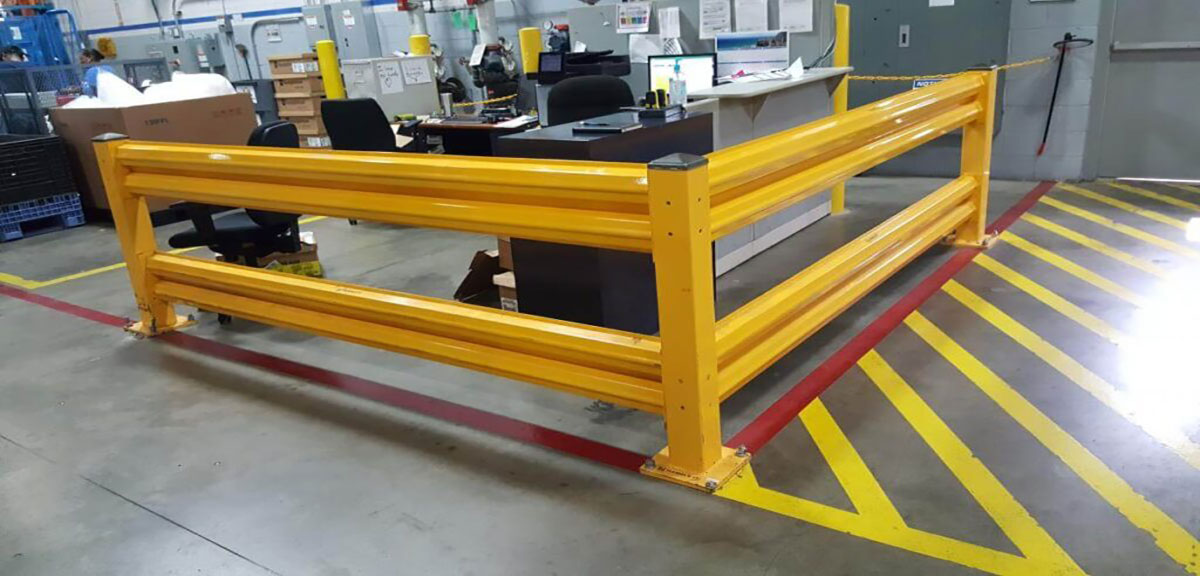Guardrails play an important role in increasing the safety and security of any warehouse or manufacturing facility. They provide safe sidewalks for employees, allow for the development of smart traffic patterns, and can easily absorb unexpected impacts from forklifts and other vehicles.
Good warehouse shelf protection saves lives and increases efficiency. Here’s everything you need to know to protect your shelves properly. If you’re shopping for a new or replacement guardrail system for your business, read on for a few frequently asked questions to help you make a more informed purchasing decision.
1. Identify Risks
First, conduct a comprehensive risk assessment of your rack to identify vulnerable areas and potential impact hotspots. This will tell you exactly what needs protection and why. The risk assessment will:
- Outstanding danger
- Identify any vulnerable areas
- Assess the likelihood of an event occurring
HSE encourages regular inspection of shelves to monitor for damage or deterioration. Periodic inspections highlight areas where changes are needed and identify specific conservation requirements.

2. Find A Solution
After you identify hazards around your shelves, you can evaluate the data to find the best solution. Previous risk assessments and accident reports will help identify any further risks and tell you how often accidents occur.
Some problems can be solved by changing processes or procedures, such as implementing a one-way traffic system. However, the data may reveal areas that require physical protection, such as:
- Workplace vehicles can damage rack legs with rack leg protectors
- End-of-shelf rails to protect the end of your aisle.
- Roadside barriers to prevent vehicle forklifts as well as any damage or injury on the ground.
- Shelf monitoring system for detection and monitoring of shelf impacts.

3. Type of Guardrail
At Aotons, we have heavy-duty guardrail systems which include safety guardrails and forklift guardrails. We tested it to hold up to 10,000 lbs at 4 mph. This system is ideal for providing your employees with physical and bright yellow barriers to protect them from forklift and motor vehicle accidents.
Our single-height posts are 18 inches tall and our double-height posts are 43 inches tall. The rails are bolted together; however, you can use an optional lift adapter to turn them into lift rails. You can also bolt lift adapters to the posts so you can slide the rails in and out without screwing them in.

4. FAQ of Guiderail Type and Installation
The following are answers to guide rail installation.
1) Can the Guardrail Attach to Multiple Side Posts?
Our rails are what we call “four-way posts”. This means they come pre-drilled on all four sides so you can attach the rails to any size. As a result, they are more versatile than end posts (with holes only on one side), line posts (with holes on two opposite sides), or corner posts (with holes on both sides). We also provide plastic plugs with each post so you can cover unused holes.
2) Does the Guardrail Have Anchors?
Yes, each post of each guardrail comes with four ¾” x 4 ¼” long wedge anchors.
3) How is the Guardrail Measured?
Guardrail measurements are always taken from the center of the post to the center of the post. This is a standard measurement for all guardrails. For example, our 10′ rail is not 120″ but 115″ because we have 5″ posts. So each half of the 5” post added to 115” constitutes 10′
4) Are Guardrails Rated?
Yes, our guardrails are rated to withstand 10,000 lbs of force moving at 4 mph. This means our rails will not deflect more than 6 inches when hit by a force moving at that speed.
5) Is “Guard Rail Rating” An OSHA Requirement?
There is no standard OSHA impact rating for guardrails. The most common industry rating is 10,000 lbs at 4 mph, but this is not an OSHA requirement.
6) Does Aotons Offer to Install Guardrail Systems?
We provide installation services through an extensive dealer network through which we sell our products. In addition to our guardrails, most of our dealers will offer installation for an additional fee.
7) How Much Does the Guardrail System Cost?
A 10-foot section of double-height fence typically sells for around $600, while a 10-foot section of single-height fence typically sells for around $350.
8) How Long Can the Guardrail Be Used?
The life expectancy of guardrails varies. The more you hit it, the more likely you’ll have to replace it. However, that means it’s doing its job. The beauty of the guardrail system is that it is modular in design. So you only have to replace the parts you hit and break. The guardrail only needs to be replaced if it hits a 10-foot section or a 100-foot section.
9) Are There Alternatives to Guardrails?
A less expensive alternative to guardrail systems is warehouse floor tape. It outlines the boundaries of forklift and pedestrian traffic. The obvious upside to this is price; however, the painful downside is that floor tape doesn’t stop forklifts from hitting pedestrians or plant assets when crossing lines.
10) Do Warehouse Guardrails Need Maintenance?
No, zero maintenance is required after installation.
11) Why Choose Aotons for Your Guardrail Needs?
With over 5 years of industry experience, Aotons can provide your warehouse or manufacturing facility with dock safety and floor-standing equipment that protects your workers and valuable assets. Our team of experts can help you find the right product you need to solve your challenge – whether it’s a highly customized system or finding a solution that fits your budget.
We have an extensive network of national and international dealers who can provide extra support wherever you are located. We proudly stand behind our products with a one- or two-year limited warranty on all materials and workmanship.

5. Install Shelf Protection
Your supplier needs to conduct an on-site survey because the structure of your facility can affect the protections they recommend. For example, rack leg protectors may have a “snap-on” feature that allows them to grip the rack, or may need to be bolted to the rack posts. The rack end rails need to be bolted to the floor.
Any shelf protection must be properly installed, as an improperly installed security system may fail to protect against impacts. Most security manufacturers provide detailed product installation instructions, and they may also provide associated installation tools.
Some suppliers will have their installation team who will install the product for you. This is the recommended method as their team will have in-depth knowledge of the products and will ensure they are installed quickly and efficiently.
6. Verify suppliers
It is crucial to choose a reputable supplier. Life and death can depend on industrial safety products’ design, manufacture, and performance. In today’s market, a lot of safety barrier manufacturers make bold claims about their product’s performance, but how do you know what safety barriers have an impact rating you can trust? Is it possible to wait until an incident occurs in the workplace before evaluating a barrier’s suitability?
It is always important to research whether a supplier’s product has been tested and approved by a recognized source such as TÜV Nord. You can be confident that these products will provide the necessary level of protection when they need it because they have been tested to replicate real-life impacts.
Suppliers shall be able to provide certificates as well as video evidence of product performance being affected by speed under appropriate test conditions. Product reviews, legitimate customer testimonials, and video case studies will provide insight into supplier trust. Additionally, they provide information about what to expect during installation.
7. Assess the cost
The initial cost of shelf protection will vary depending on the supplier you choose and the quality of the materials used. Advanced polymer protection can cost more than steel or cheap polymer alternatives, but it usually needs to be replaced much less frequently because it can withstand multiple impacts and return to its original shape.
It’s also self-colored and UV stable, so it doesn’t need any repainting. Vendors should be willing to break down costs and explain the return on investment for their products. This will help you assess which protection is best for your budget.

8. Summary
Before purchasing any shelf protectors, it is important to always
- Conduct a risk assessment.
- Identify the main risks to the shelf.
- Use the data to determine what protection is needed.
- Research vendors and their testing standards.
- Read reviews, case studies, and testimonials.
- Assess costs and consider ROI.
We hope we have given you answers to some of the more frequently asked questions about safety rail systems for warehouses and manufacturing facilities. We are happy to answer any questions you may have. At AOTONS, we can help you identify risks in your warehouse with a free on-site survey, and our professional installation team is on call to make sure your product is installed correctly. Call our sales team at +0532-86958235 or email info@aotons.com and find out what we can do for you.





Leave A Comment